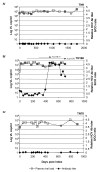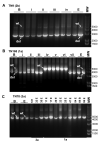High levels of subgenomic HCV plasma RNA in immunosilent infections
- PMID: 17493654
- PMCID: PMC2001282
- DOI: 10.1016/j.virol.2007.04.003
High levels of subgenomic HCV plasma RNA in immunosilent infections
Abstract
A genetic analysis of hepatitis C virus (HCV) in rare blood donors who remained HCV seronegative despite long-term high-level viremia revealed the chronic presence of HCV genomes with large in frame deletions in their structural genes. Full-length HCV genomes were only detected as minority variants. In one immunodeficiency virus (HIV) co-infected donor the truncated HCV genome transiently decreased in frequency concomitant with delayed seroconversion and re-emerged following partial seroreversion. The long-term production of heavily truncated HCV genomes in vivo suggests that these viruses retained the necessary elements for RNA replication while the deleted structural functions necessary for their spread in vivo was provided in trans by wild-type helper virus in co-infected cells. The absence of immunological pressure and a high viral load may therefore promote the emergence of truncated HCV subgenomic replicons in vivo.
Figures



Similar articles
-
Prolonged hepatitis C virus seroconversion in a blood donor, detected by HCV antigen test in parallel with HCV RNA.Vox Sang. 2004 May;86(4):266-7. doi: 10.1111/j.0042-9007.2004.00513.x. Vox Sang. 2004. PMID: 15144533 No abstract available.
-
Identification, molecular cloning, and analysis of full-length hepatitis C virus transmitted/founder genotypes 1, 3, and 4.mBio. 2015 Feb 24;6(2):e02518. doi: 10.1128/mBio.02518-14. mBio. 2015. PMID: 25714714 Free PMC article.
-
Antibody- and genome-based identification of recent HCV infection.Antivir Ther. 2012;17(7 Pt B):1459-64. doi: 10.3851/IMP2464. Epub 2012 Dec 7. Antivir Ther. 2012. PMID: 23322615 Review.
-
Hallmarks of hepatitis C virus in equine hepacivirus.J Virol. 2014 Nov;88(22):13352-66. doi: 10.1128/JVI.02280-14. Epub 2014 Sep 10. J Virol. 2014. PMID: 25210167 Free PMC article.
-
[Serological and molecular markers of HCV infection in Polish blood donors].Przegl Epidemiol. 2005;59(2):511-7. Przegl Epidemiol. 2005. PMID: 16190561 Review. Polish.
Cited by
-
Are trans-complementation systems suitable for hepatitis C virus life cycle studies?J Viral Hepat. 2013 Apr;20(4):225-33. doi: 10.1111/jvh.12069. Epub 2013 Feb 14. J Viral Hepat. 2013. PMID: 23490366 Free PMC article. Review.
-
Testing strategy to identify cases of acute hepatitis C virus (HCV) infection and to project HCV incidence rates.J Clin Microbiol. 2008 Feb;46(2):499-506. doi: 10.1128/JCM.01229-07. Epub 2007 Nov 21. J Clin Microbiol. 2008. PMID: 18032621 Free PMC article.
-
Hepatitis C Virus Deletion Mutants Are Found in Individuals Chronically Infected with Genotype 1 Hepatitis C Virus in Association with Age, High Viral Load and Liver Inflammatory Activity.PLoS One. 2015 Sep 25;10(9):e0138546. doi: 10.1371/journal.pone.0138546. eCollection 2015. PLoS One. 2015. PMID: 26405760 Free PMC article.
-
Persistent RNA virus infections: do PAMPS drive chronic disease?Curr Opin Virol. 2017 Apr;23:8-15. doi: 10.1016/j.coviro.2017.01.003. Epub 2017 Feb 17. Curr Opin Virol. 2017. PMID: 28214732 Free PMC article. Review.
-
HCV Defective Genomes Promote Persistent Infection by Modulating the Viral Life Cycle.Front Microbiol. 2018 Dec 3;9:2942. doi: 10.3389/fmicb.2018.02942. eCollection 2018. Front Microbiol. 2018. PMID: 30559733 Free PMC article.
References
-
- Aaskov J, Buzacott K, Thu HM, Lowry K, Holmes EC. Long-term transmission of defective RNA viruses in humans and Aedes mosquitoes. Science. 2006;311(5758):236–8. - PubMed
-
- Alberti A, Chemello L, Benvegnu L. Natural history of hepatitis C. J Hepatol. 1999;31(Suppl 1):17–24. - PubMed
-
- Alter MJ, Kruszon-Moran D, Nainan OV, McQuillan GM, Gao F, Moyer LA, Kaslow RA, Margolis HS. The prevalence of hepatitis C virus infection in the United States, 1988 through 1994. N Engl J Med. 1999;341(8):556–62. - PubMed
-
- Arrojo IP, Pareja MO, Orta MD, Luque FN, Lamas MC, Gordo FS, Mancha IV. Detection of a healthy carrier of HCV with no evidence of antibodies for over four years. Transfusion. 2003;43(7):953–7. - PubMed
Publication types
MeSH terms
Substances
Associated data
- Actions
- Actions
- Actions
- Actions
- Actions
- Actions
- Actions
- Actions
- Actions
- Actions
Grants and funding
LinkOut - more resources
Full Text Sources
Medical
Molecular Biology Databases

